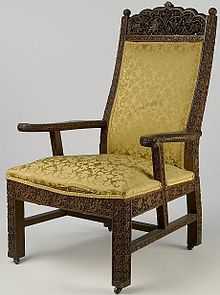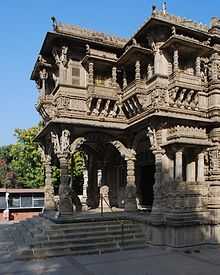Hutheesing family
The Hutheesing family (Gujarati: હઠીસિંહ ) is an old Jain family from Ahmedabad, Gujarat. Several temples and charitable institutions in Ahmedabad have been built or founded by members of this mercantile family. Krishna Hutheesing, a sister of Jawaharlal Nehru, was a member of this family by marriage.
History
The family has a known history of over 250 years. In the mid-1700s, the Mughal empire was in decline, rebellions were breaking out in several places, and general lawlessness prevailed in much of northern India. The traditional trade routes between northern India and central Asia were unworkable. Meanwhile, the European powers had established their trading interests on the coast and this presented a lucrative and safe business opportunity. To meet the changing dynamics of the era, some members of the Jain trading community moved from Osian in the Marwar region of Rajasthan to Khambhat (Cambay) in Gujarat, which was at that time a major port city and a center of the European trade. The progenitors of the Hutheesing family were among the immigrants.[1]
Initially, the wealthy and industrious immigrants were not unwelcome. They ingratiated themselves with the Mughal-appointed governors of Khambhat and prospered to the extent that they soon became the owners of a few ships that sailed abroad for trade. However, this happy situation was not to last long. The group from Osian became involved in certain intrigues and their ships were consequently confiscated by the Mughal authorities. They also lost the goodwill of the local authorities and were unable to carry on their trade in the atmosphere of suspicion and hostility. Ultimately, they abandoned direct involvement with international trade and moved inland, to the large trading city of Ahmedabad, which was ruled by a rival (albeit Mughal-appointed) satrap. Here they became prosperous traders.
Seth Hutheesing
In Ahmedabad, the community prospered in trade. Perhaps the most prosperous trader among them was Hutheesing, son of Kesrising, who amassed a colossal fortune. Hutheesing was the grandson of one of the men who emigrated from Osian to Khambhat and then to Ahmedabad. He lived during the first half of the 19th century. His descendants (both adopted and biological) took his first name as their surname and came to be known as the "Hutheesing family."
Hutheesing Kesarising was married three times. Despite his massive wealth, there was a great void in his life for many years, because neither his first wife nor his second wife produced a living male heir, although there were at least two living daughters and one boy who lived to the age of five, as also some miscarriages and other infant deaths. Worse was to follow, because his third wife (who was much younger than him) produced no child at all for several years after their marriage. This third wife was named Harkunwar and she hailed from the village of Ghogha near Bhavnagar. The two daughters were married at a young age, as per the custom of that era, and sent away to live in their marital homes. Thereafter, in keeping with Indian tradition, the couple adopted two boys of known parentage and unblemished lineage, born into poor families belonging to their own Osian (Oswal) Jain community. The boys were named Jaising and Magansing. Ironically, within a couple of years after the adoptions, Harkunwar finally became pregnant and was blessed with a son, whom they named Umabhai.
Despite the birth of a biological son, the happy couple did not neglect the adopted boys or distance them in any manner. Hindu custom and society expected them to treat their three sons alike and the couple would have been badly criticized by community members if they were unfair in any way to the adopted boys. The couple did nothing to provoke adverse comment. If Harkanwar was unstinting in her affection towards all three of her sons, Huteesing was assiduous in ensuring that they received an excellent education and training in the family business. Indeed, before his death, Hutheesing portioned out his wealth in equal measure to all his three sons, and at his death, it was the eldest adopted boy, Jaising, who officiated at his funeral as his eldest son.
Harkunwar Bai
After the death of Seth Hutheesing, his three sons carried on the family's trading business harmoniously, while his wife, Harkunwar Bai, devoted herself to prayer and charities. The entire family continued to live together in their palatial residence, Hutheesing-ni-Vadi. This was a massive haveli (Indian-style mansion-with-courtyards) built by Huteesing just outside the gates of the old walled city of Amedabad. The mansion stood within a large compound, which contained walled gardens, an orchard, mews and small houses for servants and dependents.
Hutheesing had intended to build a grand Jain temple within this compound. Before his death, Hutheesing and Harkunwar had performed the required religious ceremonies and jointly laid the symbolic "first stone" of the temple. Hutheesing had finalized the layout and plan of the temple and was in the process of arranging finances and engaging craftsmen. The task of bringing his pious dream to fruition fell upon Harkunwar and her three sons. It was Harkunwar who supervised the construction of the 52-Jinalaya Hutheesing Jain Temple within the compound of her house.[2] The temple took several years to be built. It is constructed of stone in the traditional way, without steel, cement or mortar. It is richly ornamented with intricate and beautiful stone carvings and is now regarded as one of the architectural treasures of the city. It houses 238 stone images, 83 metal images and 21 yantras. The Pratishtha (consecration) of the temple was conducted by Shantisagar Suri, a famous saint. The festivities were attended by as many as 400,000 people.[3]
When the construction of the Hutheesing Jain temple was nearing completion, and preparations were afoot for its grand consecration, the need was felt for a suitable Dharamshala to accommodate the expected visitors. It occurred to Harkunwar Bai that a Derasar or Jain monastery should be built, which would accommodate the visitors in the first instance and then serve as a center of the Jain faith for all time to come. she decided to build a Derasar, or Jain monastery in the city. The presence of such an institution would add luster and virtue to the beauty of the temple. She mentioned her wishes to her three sons, and they readily agreed that it was an excellent idea, and the Dharmanath Derasar was duly built and endowed by them, and its consecration was held a couple of days before the consecration of the temple. The Derasar is situated in the Nisha Pol precinct of Ahmedabad, in the near vicinity of the Hutheesing temple.
Harkunvar Bai, who had been much younger than her husband, lived to a ripe old age. After the death of her husband, as a pious Indian widow, she wore only plain white cotton sarees for the rest of her life, entirely gave up all jewelry and ornamentation, and spent a large portion of her waking hours in prayer. She later built two further temples, on a smaller scale, within one kilometer from her house in Ahmedabad. These are the Sambhavnath and Chintamani Parshvanath temples in the Zaveriwad neighbourhood of Ahmedabad. She commissioned the construction of a Gaushala or animal shelter for aged cattle and other animals. She constructed Piaos and Sada-varta shelters near certain Jain temples, where basic food, cool water and a shady shelter were provided free to pilgrims and devotees. She constructed and endowed a Dharamshala, or free pilgrims' inn, at Samet Shikhar, a center of Jain pilgrimage located in distant Jharkhand. She organized and funded pilgrimages for poor Jain families of Ahmedabad to travel to Samet Shikhar. She donated funds towards building the Ahmedabad Civil Hospital.[4] Her pious charities, good works and personal austerity made her a figure of veneration among the people of Ahmedabad.
The sons
He also built a school for girls[5] Maganlal Karamchand Girl's School in Ahmedabad, when general public was still not in favor of female education.
The family trade included wooden furniture in association with Lockwood de Forest,[6] which was a rage in the US then, and kundan jewellery to Tiffany's in the US.

Ahmedabad Wood Carving Company was set up in 1881 by an American interior decorator, Lockwood de Forest, in association with Maganbhai Hutheesing to export wooden furniture, carved doors, cabinets, picture frames etc.[7]
The family became known for its marital alliances. They are related to the Kasturbhai Lalbhai family as well as Jawaharlal Nehru.[8] Krishna Nehru Hutheesing was married to Gunottam P. Hutheesing, (nicknamed Raja).[9]
Ahmedabad's main art venue, Leila & Purushottam Hutheesing Visual Art Centre, as well as the Purshottambhai Maganbhai & Leila P Hutheesing Public Charitable Trust is named after Maganbhai's son Purshottambhai.[10][11] He was married to Leila (Dahiben), the daughter of Lalbhai Dalpatbhai, and the sister of Kasturbhai Lalbhai. Purushottam Hutheesing's son Gunottam was married to Jawaharlal Nehru's sister Krishna Nehru Hutheesing.
Gunottam's sister Shrimati was married to Saumendranath Tagore, a nephew of Rabindranath Tagore.[12] Shrimati had studied at Shantiniketan and had remained associated with it. Saumendranath Tagore became one of the founders of the Communist movement in India.
Rajiv Gandhi, later a prime minister of India, was born in Mumbai at the home of his uncle and aunt, Gunottam (Raja) and Krishna Hutheesing, while his parents were guests at their home located at 20 Carmichael Road in Bombay.[13]
Ajit Hutheesing, a son of Gunottam, also lived in the home and spent many years living with Nehru in his home in Delhi. He later migrated to USA in 1965 and became one of the first Indians on Wall Street when he started his investment banking career. He has three sons, Nikhil Hutheesing, Vivek Hutheesing and Ravi Hutheesing and three grandchildren, Kirin Hutheesing, Remy Hutheesing and Mirai Hutheesing.
See also
References
- ↑ [Art connoisseur in the Hutheesing mould, Sunday, 8 July 2001, http://www.gujaratplus.com/news/Ahmedabad/97112.html Move from Marwar to Gujarat]
- ↑ Mangilal Bhutoria, Itihas ki Amar Bel- Oswal, Priyadarshi Prakashan, Calcutta, 1988, p. 372-373
- ↑ અમદાવાદના પ્રસિદ્ધ હઠીસિંહના દેરાં, આચાર્ય શ્રી ‘વાત્સલ્યદીપ’ સૂરિજી https://sites.google.com/site/jainphilosophy/notes/30-12-2010
- ↑ HISTORICAL BACKGROUND http://civilhospitalamdavad.org/?page_id=115
- ↑ Ahmedabad in Sidi Sayyed ni Jali http://www.desigujju.com/gujarattourism/en/place/56/Ahmedabad_in_Sidi_Sayyed_ni_Jali
- ↑ Lockwood De Forest: Furnishing the Gilded Age With a Passion for India, Roberta A. Mayer, Lockwood De Forest, Associated University Presse, 2008 p. 64
- ↑ An Eastern Fantasia, Asleep for a Century, By MITCHELL OWENS, 24 August 2000, http://www.nytimes.com/2000/08/24/garden/design-notebook-an-eastern-fantasia-asleep-for-a-century.html?pagewanted=all&src=pm
- ↑ The politics of textiles: the Indian cotton-mill industry and the legacy of Swadeshi, 1900-1985, Simon Robert Brough Leadbeater, Sage Publications, 1993
- ↑ With No Regrets - An Autobiography, Krishna Nehru Hutheesing, Jackson Press, 2007
- ↑ Art lovers treated to Raza's masterpieces TNN 22 April 2010,http://articles.timesofindia.indiatimes.com/2010-04-22/ahmedabad/28123178_1_syed-haider-raza-art-lovers-indian-art
- ↑ Trade Marks Journal No: 1507 24/10/2011 http://ipindia.nic.in/tmr_new/tm_journal/Journal_TMR_1507.pdf
- ↑ http://articles.timesofindia.indiatimes.com/2012-05-02/ahmedabad/31537530_1_rabindranath-tagore-rabindra-sangeet-ahmedabad
- ↑ Mahatma Gandhi, Collected Works/Volume 88/Letter To Gunottam Hutheesing (5 October 1945) http://ltrc.iiit.ac.in/gwiki/index.php/Collected_Works/Volume_88/Letter_To_Gunottam_Hutheesing_(5th_October_1945)
